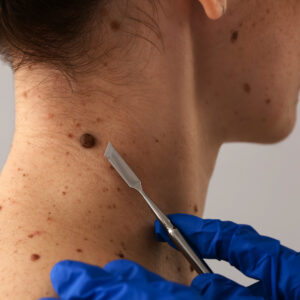mole, wart & skin tags removal treatment

mole, wart, and skin tags removal treatment is a cosmetic procedure that involves the removal of unwanted skin growths, such as moles, warts, and skin tags. this treatment is usually performed by a dermatologist or other medical professional, using a variety of methods such as freezing, cutting, or burning the growths.
Indications
People who have moles, warts, or skin tags that are causing discomfort, self-consciousness, or other issues may be candidates for this treatment. It is important to consult with a medical professional to determine if the growths are benign or potentially cancerous, as removal may be necessary for medical reason
Contraindications
People who have bleeding disorders or are taking blood thinners should not try this treatment as it may increase the risk of bleeding. Pregnant women should also avoid this treatment as it may harm the developing fetus.
Description of Procedure
Cryotherapy:
This involves freezing the growths with liquid nitrogen.
Surgical excision: this involves cutting the growths off with a scalpel or scissors.
Electrodesiccation and curettage: this involves using a small electric current to burn the growths and then scraping them away with a curette.
Course of Recovery
The recovery period for mole, wart, and skin tag removal will depend on the method used and the size and location of the growths.
Complications
Pain and Discomfort: This can usually be managed with over-the-counter pain medication.
Swelling and bruising: These side effects should subside within a few days to a week.
scarring: This may occur, but can usually be minimized with proper care during the healing process.
complications: While mole, wart, and skin tag removal is generally a safe and effective procedure, there are some potential complications to be aware of. these include:
infection: This can occur if the area is not properly cared for during the healing process.
recurrence: In some cases, the growth may return after treatment.
changes in skin colour: The treated area may be lighter or darker than the surrounding skin.
